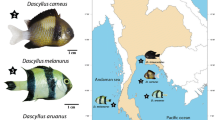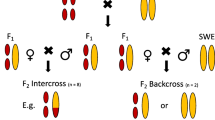Abstract
The polymorphism of the mobile elements Mdg-1 (a copia-like element) and I (an element involved in I-R hybrid dysgenesis) was analysed in a mass-mated population of Drosophila melanogaster by in situ hybridization, using biotinylated DNA probes, on polytene chromosomes. The Mdg-1 and I elements were inserted independently but were within the same bulk of DNA insertion points of the Drosophila genome, which contained on average about 30 insertion sites for each element. The X chromosome contained the lowest copy number of elements while 2R and 3R had the highest number: 3R had the highest variability. There was no correlation between the copy numbers of elements among the chromosome arms. The average expected per locus heterozygosity was equal to 0.17 for both the Mdg-1 and the I elements. Although these two elements differ in sequence, they appeared to behave similarly in the Drosophila melanogaster genome. This suggests that they may compete for target insertion sites and may be under the same control mechanisms.
Similar content being viewed by others
References
Ananiev EV, Gvozdev VA, Ilyin YV, Tchurikow NA, Georgiev GP (1973) Reiterated genes with varying location in intercalary heterochromatin regions of Drosophila melanogaster polytene chromosomes. Chromosoma 70:1–17
Ananiev EV, Barsky VE, Ilyin YV, Ryzic MV (1984) The arrangement of transposable elements in the polytene chromosomes of Drosophila melanogaster. Chromosoma 90:366–377
Belyaeva ES, Pasyukova EG, Gvozdev VA, Ilyin YV, Kaidanov LZ (1982) Transpositions of mobile dispersed genes in Drosophila melanogaster and fitness of stocks. Mol Gen Genet 185:324–328
Belyaeva ES, Ananiev EV, Gvozdev VA (1984) Distribution of mobile dispersed genes (mdg-1 and mdg-3) in the chromosomes of Drosophila melanogaster. Chromosoma 90:16–19
Biémont C (1986) Mdg-1 mobile element heterozygosity in Drosophila melanogaster, submitted
Biémont C, Belyaeva ESp, Pasyukova EG, Kogan G (1985) Mobile gene localization and viability in Drosophila melanogaster. Experientia 41:1474–1476
Brégliano JC, Picard G, Bucheton A, Pélisson A, Lavige JM, L'Héritier P (1980) Hybrid dysgenesis in Drosohila melanogaster. Science 207:606–611
Bucheton A, Paro R, Sang HM, Pelisson A, Finnegan DJ (1984) The molecular basis of I-R hybrid dysgenesis in Drosophila melanogaster: identification, cloning, and properties of the I factor. Cell 38:153–163
Bucheton A, Lavige JM, Picard G, L'Héritier P (1976) Non-Mendelian female sterility in Drosophila melanogaster: quantitative variation in the efficiency of inducer and reactive strains. Heredity 36:305–314
Chao L, Vargas C, Spear BB, Cox EC (1983) Transposable elements as mutator genes in evolution. Nature 303:633–635
Charlesworth B, Charlesworth D (1983) The population dynamics of transposable elements. Genet Res 42:1–27
Finnegan DJ, Rubin GM, Young MW, Hogness DS (1978) Repeated gene families in Drosophila melanogaster. Cold Spring Harbor Symp Quant Biol 42:1053–1063
Georgiev CP (1984) Mobile genetic elements in animal cells and their biological significance. Eur J Biochem 145:203–220
Gerasimova TI, Matyunina LV, Ilyin YV, Georgiev GP (1984) Simultaneous transpositon of different mobile elements: relation to multiple mutagenesis in Drosophila melanogaster. Mol Gen Genet 194:517–522
Gvozdev VA (1981) The nature and functions of intercalary heterochromatin in Drosophila melanogaster. In: Molecular bases of genetic processes. Proc XIV Int Congr Genet, 3, book 2, pp 257–271
Ilyin YV, Chmeliauskaite VG, Georgiev GP (1980) Doublestranded sequences in RNA of Drosophila melanogaster: relation to mobile dispersed genes. Nucleic Acids Res 8:3439–3457
Kaplan N, Darden T, Langley CH (1985) Evolution and extinction of transposable elements in mendelian populations. Genetics 109:459–480
Langley CH, Brookfield JFY, Kaplan N (1983) Transposable elements in mendelian populations. I. A theory. Genetics 104:457–471
Lewontin RC (1974) The genetic basis of evolutionary changes. Columbia University Press, New York
Montgomery EA, Langley CH (1983) Transposable elements in Mendelian populations II Distribution of copia-like elements in natural populations. Genetics 104:473–483
Nevers P, Saedler H (1977) Transposable genetic elements as agents of gene instability and chromosomal rearrangements. Nature 268:109–115
Pelisson A (1977) Contribution à l'étude d'une stérilité femelle non Mendelienne chez Drosophila melanogaster: mise en évidence d'un chromosome 4 inducteur. C R Acad Sci 284:2399–2402
Pelisson A, Picard G (1979) Non-Mendelian female sterility in Drosophila melanogaster: factor mapping on inducer chromosomes. Genetics 50:141–148
Picard G (1976) Non-Mendelian female sterility in Drosophila melanogaster: hereditary transmission of I factor. Genetics 83:107–123
Picard G (1978) Non-Mendelian female sterility in Drosophila melanogaster: further data on chromosomal contamination. Mol Gen Genet 164:235–247
Picard C, L'Héritier P (1971) A maternally inherited factor inducing sterility in D. melanogaster. Dros. Inf Serv 46:54
Piece DA, Lucchesi JC (1981) Analysis of a dispersed repetitive DNA sequence in isogenic lines of Drosophila. Chromosoma 82:471–492
Preston CR, Engels WR (1984) Movements of P elements within a P strain. Dros Infor Serv 60:169–170
Rose MR, Doolittle WF (1983) Molecular biological mechanisms of speciation. Science 220:157–161
Rubin GM, Brorein WJ, Jr, Dunsmuir P, Flavell AJ, Levis R, Strobel E, Toole JJ, Young E (1981) Copia-like transposable elements in the Drosophila genome. Cold Spring Harbor Symp Quant Biol 2:619–628
Strobel E, Dunsmuir P, Rubin GM (1979) Polymorphisms in the chromosomal locations of elements of the 412, copia and 297 dispersed gene families in Drosophila. Cell 17:429–439
Tchurikov NA, Ilyin YV, Skryabin KG, Ananiev EV, Bayev AA, Krayev AS, Zelentsova ES, Kulguskin VV, Lyubomirskaya NV, Georgiev GP (1981) General properties of mobile dispersed genetic elements in Drosophila. Cold Spring Harbor Symp Quant Biol 45:655–665
Young MW, Schwartz HE (1981) Nomadic gene families in Drosophila. Cold Spring Harbor Symp Quant Biol 45:629–640
Zhimulev IF, Semeshin VF, Kulichkov VA, Belyaeva ES (1982) Intercalary heterochromatin in Drosophila. I. Localization and general characteristics. Chromosoma 87:197–228
Author information
Authors and Affiliations
Rights and permissions
About this article
Cite this article
Biémont, C. Polymorphism of the Mdg-1 and I mobile elements in Drosophila melanogaster . Chromosoma 93, 393–397 (1986). https://doi.org/10.1007/BF00285819
Received:
Issue Date:
DOI: https://doi.org/10.1007/BF00285819




